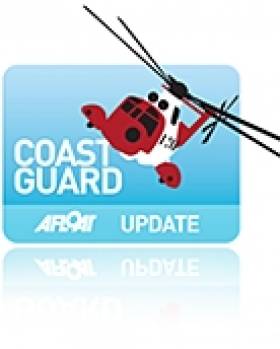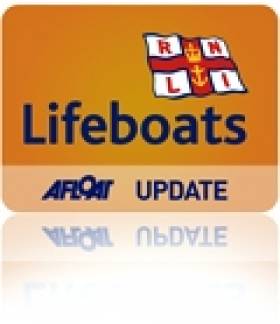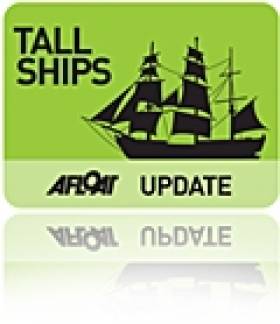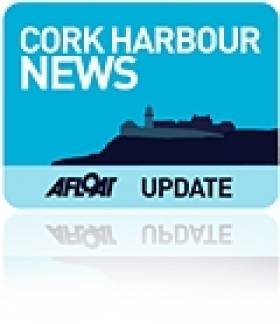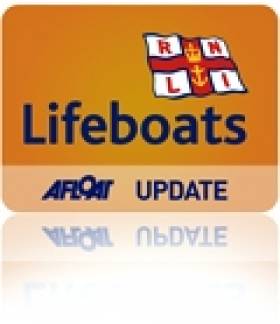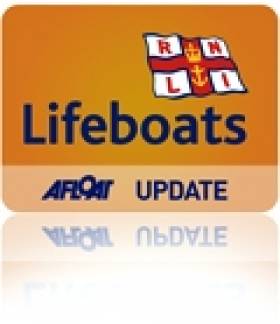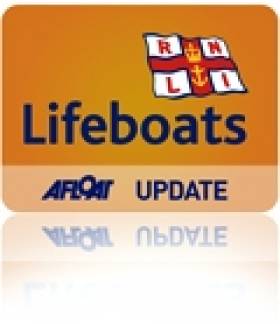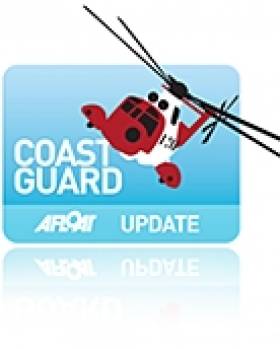Displaying items by tag: Lifeboat
Kitesurfer Rescued off Liverpool
Liverpool Coastguard was contacted by Wirral Lifeguards who had been watching a kite surfer who had returned to sea to retrieve his lost kite in strong winds and a choppy sea. The kite which he was using was seen to come down in the sea. Lifeguards used a jet ski to look for the kite surfer but on arrival at the scene could only find two kites and no kite surfer.
Liverpool Coastguard requested the attendance of RNLI New Brighton inshore lifeboat and a rescue helicopter from RAF Valley and a search began for the kite surfer.
The kite surfer was located by the lifeboat about a mile offshore and recovered to shore.
Liverpool Coastguard Watch Manager Paul Parkes says,
"The kite surfer was lucky to be found because it is hard to spot a head in a black wet suit in choppy water like today. The combination of strong offshore winds and an outgoing tide created difficult conditions for making back to shore. Fortunately he was able to lift his board up out of the water when he heard the lifeboat engines in his vicinity.
Coastguard warns water sports enthusiasts to always check conditions and tides before setting off. Don't go alone and always wear a personal flotation device, (PFD). Wear bright clothing which will help you be located if you get into difficulty."
Two Rescued from Cruiser on Lough Derg
At 12.24hrs September 7 Lough Derg RNLI Lifeboat launched, following a request by Valentia Coast Guard to assist a vessel aground close to Terryglass Harbour at the Northern end of Lough Derg. The lifeboat, with helm Johnny Hoare, Ger Egan and David Moore on board, was alongside the casualty vessel at 12.51hrs. Winds were West Southwest, Force 4 gusting 5, with frequent squally showers reducing visibility.
The vessel was aground very close to the shore and the two persons on board were safe and unharmed. Two other passengers had walked to shore and made their way by road to Terryglass Harbour. The vessel had got into difficulties after it had gone to the assistance of another cruiser; this other vessel had made it's way to safe water and was tied alongside at Terryglass Harbour when the lifeboat arrived on scene. The vessel was taken off the rocks at 13.25hrs, she had suffered a lot of damage to her props but was not holed. With an RNLI crew member on board the vessel was towed to Terryglass and was tied alongside at 13.50hrs.
The lifeboat returned to station was ready for service again at 14.35hrs. Helm Johnny Hoare said that he was "pleased with the progress of the rescue considering the conditions on the lake and the position of the boat in very rocky water".
Sail Training Vessel Rescued by Weymouth RNLI (Video here.)
The crew of the Weymouth RNLI relief Severn class all-weather lifeboat Beth Sell assisted a 24 metre sail training vessel with 16 persons onboard that was dismasted South of Portland Bill. The footage taken by crew members iphones and pentax hand held camera. SCROLL DOWN FOR VIDEO
Storms continued to batter Britain and Ireland's coast today as autumn arrived with a roar as forecasters warned the unsettled conditions could last for two weeks.
The Sail Training Vessel's wooden 90ft tall mast broke in half in the force seven winds and the boom, sail and rigging plunged into the choppy 12ft seas.The crew of the stricken yacht, who were all young adults, were unable to retrieve the stricken mast in the poor conditions and called the Coastguard for help.
The Weymouth RNLI lifeboat rushed to the scene at around 5.35pm yesterday.
None of the sailors were injured in the incident, although some were suffering from seasickness in the rough conditions.
The Daily Mail has more here
100 Boats Expected for Saturday's Cobh to Blackrock Yacht Race
This historic race – sponsored by the Port of Cork – will again feature strongly as one of the biggest events supporting this years Cork Harbour Open Day
Starting at midday off Cobh Promenade the race will continue along its traditional route passing Ringaskiddy, Monkstown, Passage, across Loch Mahon and along to the finish at Blackrock Castle.
All boats are then invited to continue up to the City Quays where complimentary berthing will be provided by the Port of Cork at the Cork City Marina.
A barbecue and usual refreshments will be available at the Boardwalk Restaurant (just opposite the City Pontoon) along Lapps Quay. The prize-giving will take place during the afternoon at the Boardwalk. Crews, their families and friends will have plenty of time to relax and enjoy themselves as we wind up the CSC laptop (and operators) to collate the dozens of times across all manner of classes in to a meaningful set of results.
The club would appreciate it if competitors would come along to support the after race festivities and prize-giving, especially if you think you may have won something. As always, the race is free to enter and a collection will be held for the RNLI during the afternoon.
A Wedding Gift that Will Save Lives at Sea
Newly married couple Jackie and Peter Gracey have presented RNLI Bangor Branch with a cheque for £1403.86. Three weeks ago Mr and Mrs Gracey held a wedding party at the Ballholme Yacht Club and in lieu of wedding presents they had requested that a donation be made to Bangor RNLI.
The presentation was made during the RNLI Bangor Lifeboat BBQ held at Ballyholme Yacht Club.
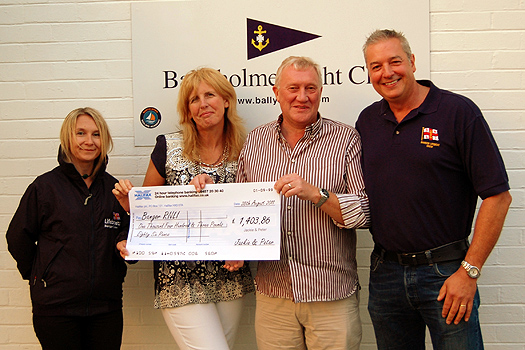
Jackie and Peter (centre) present their cheque
During the evening crew members and guests raised over £1500.00 for the Royal National Lifeboat Institution Bangor Branch.
RNLI senior helmsman Kyle Marshall said 'We would like to thank everyone who attended the crew BBQ and helped raise this fantastic sum of money.' He added 'Special thanks must go to Jackie and Peter; their very special wedding gift will save lives at sea, on behalf of the crew at Bangor Station I would like to wish them a very happy future together.'
Lifeboat volunteer crew at Bangor have launched on service numerous times this year, in all weather conditions and on many occasions during the hours of darkness.
The majority of call outs have been to leisure craft including canoes, powerboat, yachts and speedboats. Difficulties have been caused in the most part by mechanical failure of one kind or another. The rescues have been diverse, taking RNLI's Bangor Lifeboat right across Belfast Lough to Black Head and up towards Belfast as far as the M3 bridge over the River Lagan. Rescues are not always confined to boats in distress. A number this year have been related to suspected attempted suicides and missing persons, others have been to people stranded on rocks caught by the rising tide.
Wicklow Lifeboat Tows Yacht to Safety After Rope Fouls Prop
The yacht with two persons onboard was taking part in a race along the Wicklow coast when the mast and rigging was damaged, the skipper attempted to use the engine but a rope had fouled the propeller leaving the vessel drifting helplessly.
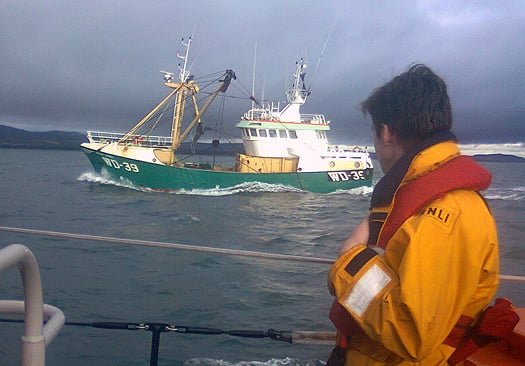
Wicklow lifeboat tows the yacht to safety last night
The lifeboat crew under the command of Coxswain Ciaran Doyle located the stricken yacht about one mile east of the North Arklow buoy and was alongside less than 30 minutes after launching. Once a towline had been rigged by the lifeboat crew the casualty was taken under tow to Wicklow harbour. The yacht was secured alongside the south quay at 7pm and the two sailors were landed safely ashore. This was the second incident the volunteer crew responded to over the weekend.
Lough Derg Lifeboat Investigates Reports of Unmanned Cruiser
At 17.05hrs Lough Derg RNLI Lifeboat launched with helm Eleanor Hooker, Peter Clarke and Ben Ronayne on board. As the lifeboat made its way to the casualty vessel, it was established that the skipper of the vessel, safe and unharmed, had been taken by a passing motor boat to Garrykennedy Harbour. It was noted that some boats, having seen the cruiser, were navigating the wrong side of the Mountaineer. The lifeboat took the skipper back to his vessel. The craft was not holed but had suffered damage to its props. With the boat's skipper and a lifeboat crew member on board, the vessel was taken off the rocks and towed to Williamstown Harbour, where it was tied up safely alongside at 18.40hrs. The lifeboat returned to station and were ready for service again at 19.00hrs.
Earlier today, at 10am Lough Derg RNLI lifeboat, Toshiba Wave Warrior, went to the assistance of 4 persons on board a 40ft cruiser that had run aground close to the mouth of the river in Terryglass Bay. The crew had hoisted their distress flag to draw attention to their dilemma.
At 10.45hrs on Sunday August 22, the crew of Lough Derg RNLI Lifeboat, helm Peter Clarke, Dom Sharkey and Ben Ronayne came across a vessel aground and flying her distess flag whilst out on exercise at the northern end of Lough Derg. They alerted Valentia Coast Guard that they were going to assist. Winds were westerly force 3 and visibility was very good. The vessel, which had been aground for two hours, had four crew, two of whom were in the water inspecting the hull. They were advised to get back onboard and to change into warm dry clothes. Having establishing that the boat was not holed, the lifeboat took her off the rocks and towed her to the safety of Portumna Castle Harbour, where she was tied up alongside at 11.20hrs. The lifeboat returned to station and was ready for service again at 12.57hrs
While it might be an exaggeration to say that all of the 21 crew members of Rambler 100 owe their lives to the Irish Search and Rescue service, there are certainly five people whose future prospects were greatly improved by the operation off the Fastnet Rock on August 15th. A lot of media focus has been on Coxswain Kieran Cotter and the crew of Baltimore Lifeboat as well as lifeboat mechanic Jerry Smith, whose dive boat, on charter to the media team of one of the competitors, was on hand to search and recover the five drifting crew. There is no question that this focus is appropriate. RNLI crews all over the UK and Ireland deserve the attention, not only because of their extraordinary voluntary dedication to the cause, but also because such publicity helps swell the coffers of the charity. The service could not operate without the generosity of the donors and incidents such as these help fill the blue boat-shaped boxes held by even more RNLI volunteers.

Saved: Ireland's Rescue Services Answered the Call of the capsized Supermaxi Rambler 100 off the Fastnet Rock. Photo: Team Phaedo
The dramatic stories and pictures dominating the media show the front line of a quite wonderful resource that is Search and Rescue in Ireland today. Baltimore Lifeboat was at the coal face of an intricate network of operations, triggered by the crew's EPIRBs. Irish Coast Guard radio officers in Valentia responded almost immediately tasking the rescue resources, working the phones and computers to confirm that this was not an accidentally triggered EPIRB, contacting RORC HQ, determining search patterns and relaying the information to the scene. It was the backroom contacts between RORC and the Coast Guard in endeavouring to contact Rambler 100 using satellite phones that confirmed the possibility of a catastrophic incident involving the Supermaxi. The subsequent tasking of the Shannon and Waterford based Sikorsky helicopters led to the medevac of crew member Wendy Touton and timely treatment of her hypothermic condition, initially by the on-board paramedics and later at Tralee General hospital. And Coast Guard involvement didn't end with the successful rescue – the shoreside operation to provide food and shelter in Baltimore was coordinated by Coast Guard personnel and the salvage operation of the hull of Rambler 100 was overseen by the Irish Coast Guard.

Rambler crew are recovered from the water after a SAR operation by the Irish Coastguard Photo: Team Phaedo. More photos here.
That Ireland has probably one of the best Search and Rescue services in the world goes back to the campaign initiated in 1988 by Joan McGinley, following the death, within sight of land of Donegal fisherman John Oglesby, whose leg was severed in a trawl winch. Eamon Doherty, the late former Garda Commissioner chaired the review group established in response to the campaign and his report led to the establishment of the Irish Marine Emergency Service, subsequently the Irish Coast Guard. Under the guidance of Director Capt Liam Kirwan, the new service moved quickly to become not only the central co-ordinating body for Search and Rescue, but developed its own resources, notably the helicopters, previously tasked in from Irish Air Corps and UK SAR.
Another element that will feature in the Rambler 100 incident is the Marine Casualty Investigation Board (MCIB), set up from recommendations arising from a review of the handling of investigations into marine casualties.
It might be thought that the incident is now closed, but there are many unanswered questions and the investigation will be looking at these and making recommendations that should improve safety in this sector. These questions will include EPIRB performance, liferaft deployment and grab bag usage, but perhaps the key issue yet to be determined is why the response from fellow competitors didn't appear to happen. Even if Channel 16 wasn't being actively monitored, and if not why not, shouldn't the Mayday set off by the Coast Guard have set off the DSC alerts on the radios of Rambler 100's fellow competitors? Had the incident occurred several hours later or earlier when Rambler 100 could have been up to 100 miles from the nearest land, when conditions worsened, we could be looking at much more serious consequences.
It is heartening to think that, in this small country of ours in troubled times, not only do we have a shining star in our search, rescue, recovery and restore system, involving professionals and volunteers cooperating for the greater good, we also have a system that determines the nature of incidents so that we can all learn from the experience.
And let us not forget those people and services, such as the Gardai, Navy, Army and the community of Baltimore who are outside the media spotlight who contributed to this happy ending.
Afloat's Latest Coastguard News
Afloat's Latest RNLI Lifeboat News
Afloat's Latest MCIB News
DSC Alert Sends Rescuers Straight to Scene of Sinking Vessel
The digital selective calling (DSC) alert requesting immediate assistance was received at just after 8.15pm. Using AIS and DSC the vessel was located just off Runabay Head and identified as the Katoni. RNLI lifeboats from Redbay and Larne were sent to the scene whilst the police helicopter flew overhead. Ballycastle Coastguard Rescue Team were also sent to the scene to assist.
The area was thoroughly searched and no vessel was found. At just after 9.30pm a 999 call came in from one of the three crew to say although the vessel had been taking on water they had made it safely to shore.
Belfast Coastguard Watch Manager Alan Pritchard said;
"The crew of this vessel was extremely well prepared. They were wearing lifejackets, had a DSC radio and knew how to use it. Because of this they were able to call for immediate assistance and although they couldn't actually talk to us we knew where they were and that they needed help. They also had the presence of mind to let us know that they had reached the shore safely so we were able to call off the search."
Rambler 100 Crew Member 'Feels Lucky to be Alive'
An Australian crewmember on the stricken Rambler 100, which capsized in high winds during yesterday's Rolex Fastnet Race, has told reported that he feels "lucky to be alive".
Mike Motti was one of five crew who were separated from the yacht when it overturned near Fastnet Rock off the Cork coast.
He and his fellow crewmembers spent two hours adrift on a liferaft before they were rescued in foggy conditions which made the search all the more difficult.
“I’m feeling lucky to be alive, happy to be here and it’s great to see the local people here to greet us,” Motti told The Irish Times.
Fellow crewman Michael van Beuren said the yacht capsized within 30 seconds when its keel fin snapped in heavy seas.
All 21 crew were rescued from the yacht last night in an operation led by the Baltimore RNLI lifeboat and the Irish Coast Guard.



























